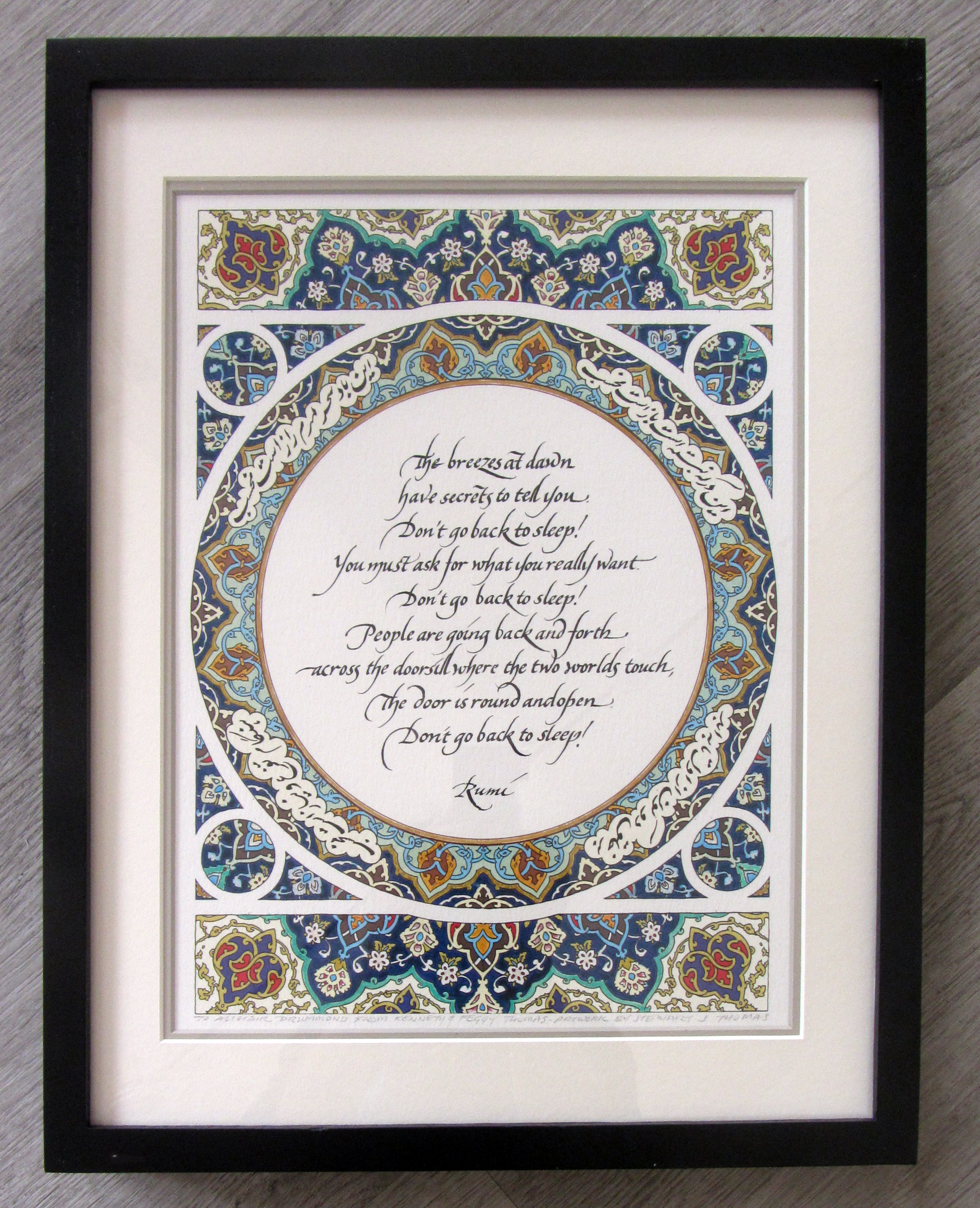For poetry in Persian / Farsi, calligraphy is the natural partner. I receive many requests to calligraph the works of both classical and contemporary Persian poets and to produce calligraphic art for framing, weddings, book publication, tattoos and even jewelry. In addition I often have to help research the original Persian / Farsi source of poetry that may be available to you only in English or in partially remembered form handed down orally in your family. To read more about some of the great poets please scroll down below the image gallery.
As an example of poetry in Persian / Farsi calligraphy, I recently completed this original hand painted design featuring Rumi’s poetry in Persian and in translation. Artwork framed to 14 x 18 inches (35 x 45 cm). Scroll down to see more calligraphy treatments of poetry in Persian, Arabic and Urdu.

Rumi, Breezes at Dawn
The poetic tradition is one of the prime sources for the Persian calligraphic arts. There are scores of famous poets in the classical tradition as well as many more that are deserving of greater fame. The world of contemporary literature also features many wonderful poets.
I will update this list over time, but here is a start to familiarize with some of the great poets:
Rumi (Jalāl ad-Dīn Muhammad Rūmī), (1207-1273), often known as Mowlana, مولانا, or Molavi, مولوی, is now one of the most quoted poets in the world. An international figure even in how own day, his works are enjoying a new life throughout the world. Many people come to Rumi through his works in translation. I am often asked to locate the original Persian (Farsi) lines of poetry. This task requires patience because Rumi’s works are voluminous and there is no index or even agreed-upon standard edition. Thankfully I enjoy reading Rumi’s work in the original and I am also in touch with a network of Rumi scholars who are wonderful allies in tracking down the master’s words. #rumi #rumicalligraphy #rumiart #rumipoetry #persiancalligraphy
Kahlil Gibran (جبران خليل جبران) (1883-1931) is another poet known widely in translation. His works gained worldwide fame during his lifetime and have remained popular ever since. Born in Lebanon, Gibran wrote in both Arabic and English. His most popular work, The Prophet, has remained in print since its initial publication in 1923. I have produced many calligraphic pieces featuring Gibran’s work. #gibran #kahlilgibran #theprophet #arabiccalligraphy
Kabir (15th Century) (कबीर) is revered as a poet, mystic and saint in both Muslim and Hindu communities. His work is remarkable for its infusion of many languages brought together in simple, direct and beautiful expression. Many of these have been put to music and are an integral part of the musical tradition of India. Kabir’s works can be written in both Urdu calligraphy, which uses a modified form of the Arabic script, or in Devanagari calligraphy, which is the same alphabet used to write Hindi, Sanskrit and many other North Indian languages. #Indiapoetry #Indianpoetry #Kabir #SantKabir #Hindipoetry
Mahmoud Darwish (1941-2008) (محمود درويش) gave voice to the Palestinians in the latter half of the 20th century, served as editor of a literary magazine in Israel, and received numerous literary and peace prizes. His language is modern, direct, poignant and eloquent. I have produced a number of pieces featuring the poetry of Darwish in contemporary Arabic calligraphy. #Darwish #Mahmoud Darwish #Arabiccalligraphy #Arabicpoetry
Ibn Arabi (1165-1240) is revered as an outstanding scholar, poet and Sufi Saint. He lived in Andalusia (Spain) and produced some 800 works, of which over 100 had survived. I enjoy Ibn Arabi’s poetry for its rich imagery and use of metaphor as he explores the entwined natures of the human and the divine. The earliest successful Arabic calligraphy rondel I created is the text of Ibn Arabi’s famous poem which begins “O Marvel! a garden amidst the flames. My heart has become capable of every form.” #IbnArabi #Arabiccalligraphy #Arabicpoetry #IbnArabipoetry #Arabic #Sufipoetry
Persian Poets: The work of the Persian poets is known and quoted as part of everyday life in a wide swath of South, Central and Western Asia. The Sufi poets are particular favorites of mine. Classical poets include Roudaki, Ferdowsi, Hafiz (Hafez), Sa’adi, Khayyam and Attar of Nishapur. Modern poets whose work I enjoy include Sohrab Sepehri, Forough Farrokhzad. Poetry, music and calligraphy all intersect in Iranian culture as loci for improvisation and the heartfelt expression of love, loss, and personal, political and spiritual longings and aspirations.
The poetic tradition is so rich and vital among Persian poets, Arab poets and Urdu poets. This tradition is carried forth by men and women, singers and musicians, and the millions of people who memorize and use poetry as part of everyday life. As a speaker of Persian, my familiarity is greatest with the Iranian poets, although I enjoy reading poetry in Arabic, Urdu and Hindi, piecing the words and meanings together slowly. And of course I also read poetry in two other languages in which I have some education: English and Chinese.
I welcome all inquiries and commissions for poetry calligraphy. Suggested formats include the rondel, the illuminated manuscript-style page, the Persian format of the Siahmashq (سياه مشق or سيامشق), zoomorphic designs, and contemporary layouts.